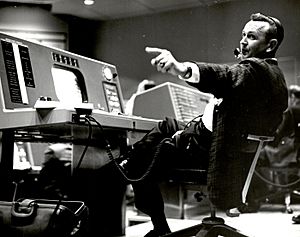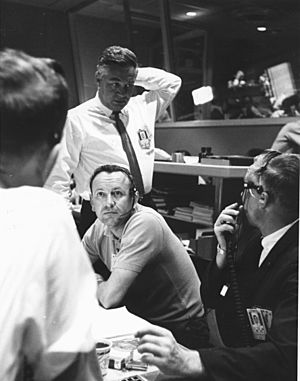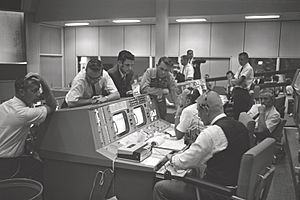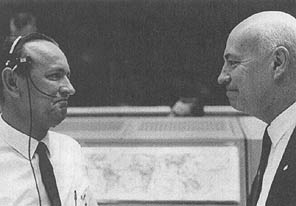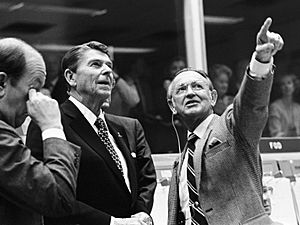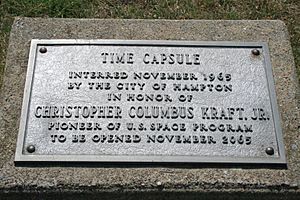Christopher C. Kraft Jr. facts for kids
Quick facts for kids
Christopher C. Kraft Jr.
|
|
|---|---|
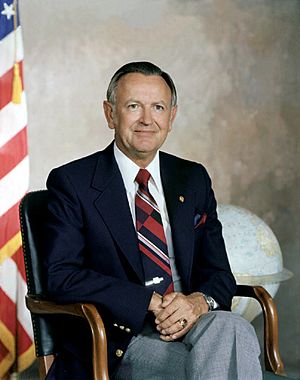
Kraft as director of Johnson Space Center in 1979
|
|
| Born |
Christopher Columbus Kraft Jr.
February 28, 1924 Phoebus, Virginia, U.S.
|
| Died | July 22, 2019 (aged 95) Houston, Texas, U.S.
|
| Alma mater | Virginia Tech, B.S. 1944 |
| Occupation | NASA flight director Director of Johnson Space Center |
| Spouse(s) |
Betty Anne Kraft
(m. 1950) |
| Children | 2 |
| Awards |
|
Christopher Columbus Kraft Jr. (born February 28, 1924 – died July 22, 2019) was an American engineer who played a huge role in creating NASA's Mission Control Center. He helped shape how NASA worked and its culture. Many people say that the Control Center today is a reflection of his ideas.
After graduating from Virginia Polytechnic Institute and State University in 1944 with a degree in aeronautical engineering, Kraft joined the National Advisory Committee for Aeronautics (NACA). This was the organization that came before NASA. In 1958, he joined the Space Task Group, a small team whose job was to put the first American in space. Kraft became NASA's first flight director. He was in charge during America's first crewed spaceflight, first crewed orbital flight, and first spacewalk.
Later, during the Apollo program, Kraft stopped being a flight director to focus on managing and planning missions. In 1972, he became the director of the Manned Spacecraft Center (which later became the Johnson Space Center). He held this important job until he retired in 1982.
After retiring, Kraft worked as a consultant for companies like IBM. In 1994, he led a group that looked at how to make NASA's Space Shuttle program more affordable. This report, known as the Kraft report, suggested that private companies should run the Space Shuttle operations.
Kraft wrote his autobiography, Flight: My Life in Mission Control, in 2001. In 2011, the Mission Control Center building was named after him. He was known as a key person in the U.S. human spaceflight program from its very start to the Space Shuttle era.
Contents
Early Life and Education
Christopher Columbus Kraft Jr. was born in Phoebus, Virginia, on February 28, 1924. He was named after his father. His mother, Vanda Olivia, was a nurse. As a boy, Kraft was a state champion bugler. He also loved baseball and played in college.
In September 1941, Kraft started studying at Virginia Polytechnic Institute and State University. He tried to join the United States Navy during World War II but was not accepted because of a hand injury he had as a child. He graduated in December 1944 with a degree in aeronautical engineering.
Starting His Career at NACA
After college, Kraft took a job with the National Advisory Committee for Aeronautics (NACA). This government agency focused on advanced aircraft research. Kraft worked in the flight research division. His work included developing systems to help aircraft fly smoothly in bumpy air. He also studied wingtip vortices, which are swirling air currents left behind by planes.
Kraft enjoyed his work, but it was also very stressful. In 1956, he started thinking about a different career path.
Becoming a Flight Director
How Mission Control Began
When Russia launched Sputnik 1 in 1957, the United States sped up its space program. In 1958, NASA was created. Kraft was invited to join a new group working on putting a person into orbit. He accepted and became one of the first 33 people in the Space Task Group. This was the start of America's first human space program, called Project Mercury.
Kraft was put in charge of planning how to operate the Mercury spacecraft during flight. He also planned how to control and monitor missions from the ground.

One of Kraft's biggest ideas was the concept of a mission control center. He realized that astronauts would need constant support from engineers on the ground. These ideas shaped the Mercury Control Center in Florida. Kraft also came up with the idea of a flight director. This person would lead the team of engineers and make real-time decisions during a mission. Kraft wanted to be that person, and so the role of flight director was born.
An important test for Kraft and Mission Control was the flight of Mercury-Atlas 5. This mission sent a chimpanzee named Enos into orbit. The flight was supposed to last three orbits. However, a problem with the spacecraft's controls forced Kraft to decide to bring the capsule back after two orbits. This showed Kraft how important it was to make quick decisions in Mission Control. It also made him feel the huge responsibility he had for the lives of those in space.
Mercury Missions
Kraft was the flight director for all six crewed Mercury missions. The flight of Mercury-Atlas 6 with John Glenn in 1962 was a big challenge. During the flight, a signal suggested that the capsule's heat shield might be loose. A loose heat shield could cause the capsule to burn up during re-entry.
Kraft believed the signal was false. However, his bosses told him to tell Glenn to keep the retrorocket package on during re-entry. This package was strapped over the heat shield and might hold it in place. Kraft worried that if the retrorockets still had fuel, they could explode. But he followed the plan.
Glenn landed safely. An inspection showed that Kraft was right; the heat shield was not loose. This experience taught Kraft that he needed to trust his own judgment in Mission Control.
Before the flight of Mercury-Atlas 7, Kraft was concerned about Scott Carpenter being the astronaut. The mission had problems, including high fuel use and a delayed re-entry. Kraft felt frustrated by Carpenter's communication and attention to duties. He later wrote in his autobiography that "The Man Malfunctioned." Carpenter disagreed, saying that in space, things happen so fast that only the pilot truly knows what to do.
Gemini Missions
During the Gemini program, Kraft became the head of mission operations. He led a team of flight directors. Because Gemini missions were longer, Mission Control worked in three shifts. Kraft was very good at teaching and trusting his new flight directors.
The Gemini program had many "firsts" for NASA, like the first flight with two astronauts, the first meeting of two spacecraft in space, and the first spacewalk. Kraft was on duty for many of these events. During America's first spacewalk on the Gemini 4 mission, Ed White was so amazed by the view of Earth that he delayed returning to the capsule. Kraft had to make sure White returned safely, even though he understood White's excitement.
After Gemini 7, Kraft stepped back from being a flight director to focus on planning for the Apollo program.
Apollo 1 Fire
Kraft was supposed to be the lead flight director for the first crewed Apollo mission. But on January 27, 1967, a fire broke out during a test on the launchpad. All three astronauts were killed. Kraft was in Mission Control in Houston, listening to the radio. There was nothing anyone could do. Kraft was a pallbearer at astronaut Gus Grissom's funeral.
Public Recognition
Kraft became well-known in America during the 1960s. He was featured on the cover of Time magazine in 1965, called the "Conductor in a Command Post." The article compared his role as flight director to an orchestra conductor. Kraft was surprised to be on the cover, thinking his boss, Bob Gilruth, should have been there instead.
Working with Astronauts
After John Glenn's flight, Kraft decided he would not let anyone outside Mission Control overrule his decisions. The mission rules stated that the flight director could take any action needed for a successful mission. Kraft believed this meant he had control over the astronauts' actions too.
For example, during the Apollo 7 mission, commander Wally Schirra refused some orders from the ground. Kraft decided that none of the Apollo 7 crew would fly in space again. Schirra had already planned to retire, but this showed Kraft's authority. Kraft had made a similar decision about Scott Carpenter after his Mercury mission, saying Carpenter would never fly in space again. He didn't.
Manager and Mentor
Apollo Mission Planning
After the Apollo 1 fire, Kraft realized his management duties would keep him from being a flight director on future missions. His role in the Apollo program became more about overall planning.
Kraft was one of the first NASA managers to discuss sending Apollo 8 on a flight around the Moon. This idea came up because there were delays with the Lunar Module. The plan was to fly Apollo 8 in December, which gave Kraft's team very little time to prepare. Kraft worked with his planners and flight directors to see if they could be ready. He remembered it as "one hell of a challenge."
On Christmas Eve, 1968, Apollo 8 orbited the Moon. Kraft and Gilruth sat together in Mission Control, thinking about how far they had come.
Kraft watched the Apollo 11 Moon landing from Mission Control. He played a more active role during the Apollo 13 crisis. He was called into Mission Control right after the accident and helped decide the best way to bring the crew home safely.
A Great Teacher
Many Apollo engineers who later became top managers saw Kraft as one of the best leaders. He personally chose and trained a whole generation of NASA flight directors, including John Hodge, Glynn Lunney, and Gene Kranz. Kranz called Kraft "The Teacher." Kraft created a culture of trust within Flight Operations.
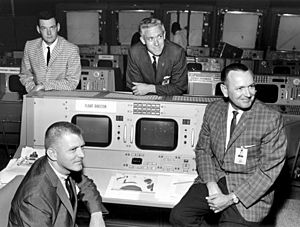
Kraft was also a tough boss. He made it clear that there was no room for mistakes in his division. He had the power to end careers if people didn't meet his high standards.
Center Director
In 1969, Kraft became the deputy director of the Manned Spacecraft Center (MSC). On January 14, 1972, he became the director, taking over from Gilruth, his mentor. Many people saw Kraft as an excellent leader for the center.
Kraft could have retired in the early 1980s, but he stayed on. In 1981, he had some disagreements with NASA leaders about the STS-2 mission and how NASA was managed. In April 1982, Kraft announced he would step down as center director at the end of the year.
Retirement and Legacy
Consultant Work
After retiring, Kraft worked as a consultant for companies like Rockwell International. In 1994, he led a team to study how to make the Space Shuttle program more cost-effective. Their report, the Kraft report, suggested that a single private company should take over Space Shuttle operations. It also said that the Space Shuttle was a "mature and reliable system."
This report was debated at the time. Nine years later, after the Columbia disaster, the Columbia Accident Investigation Board (CAIB) looked at the Kraft report. They said it had contributed to a culture where NASA might have seen the shuttle as too safe, rather than still needing careful engineering attention.
Autobiography
In 2001, Kraft published his autobiography, Flight: My Life in Mission Control. Reviewers praised his honest storytelling and how he wasn't afraid to criticize those he disagreed with.
Personal Life
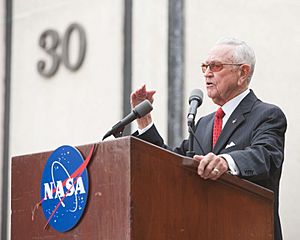
In 1950, Kraft married Betty Anne Turnbull, whom he met in high school. They had two children, Gordon and Kristi-Anne. Kraft admitted in his book that his demanding work at NASA meant he was often away from his family.
Kraft was a member of the Episcopal Church. He was also a keen golfer.
Christopher Kraft Jr. passed away on July 22, 2019, in Houston, at the age of 95. This was just two days after the 50th anniversary of the Apollo 11 Moon landing.
Awards and Honors
Kraft received many awards for his work. After the Mercury program, President John F. Kennedy gave him the NASA Outstanding Leadership Medal. He received the NASA Distinguished Service Medal four times.
He also won the Distinguished Citizen Award from Hampton, Virginia, in 1966. In 1999, he received the National Space Trophy, which called him "a driving force in the U.S. human space flight program."
In 2006, NASA gave Kraft the Ambassador of Exploration Award, which included a sample of Moon rock from Apollo 11. Kraft gave this award to his old university, Virginia Tech. He was added to the National Aviation Hall of Fame in 2016. The Mission Control Center at the Johnson Space Center was renamed the Christopher C. Kraft Jr. Mission Control Center in his honor in 2011. Kraft Elementary School in Hampton, Virginia, is also named after him.
In Media
Kraft has been shown in several films and TV shows. He was played by Stephen Root in the 1998 miniseries From the Earth to the Moon. He was also in many documentaries about the space program. In the 2018 film First Man, he was played by J. D. Evermore. In the 2020 miniseries The Right Stuff, he was played by Eric Ladin.
See also
 In Spanish: Christopher C. Kraft para niños
In Spanish: Christopher C. Kraft para niños


